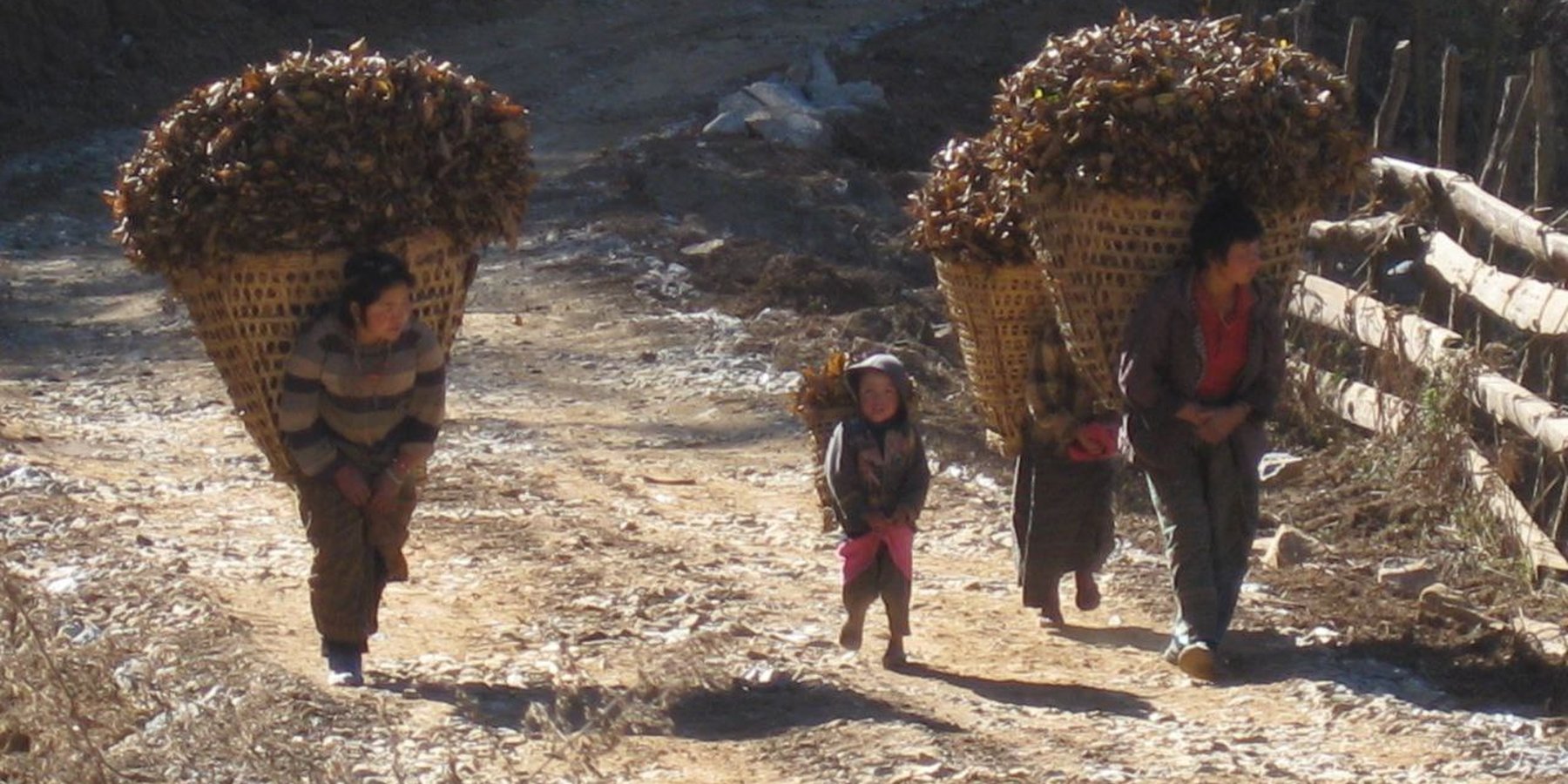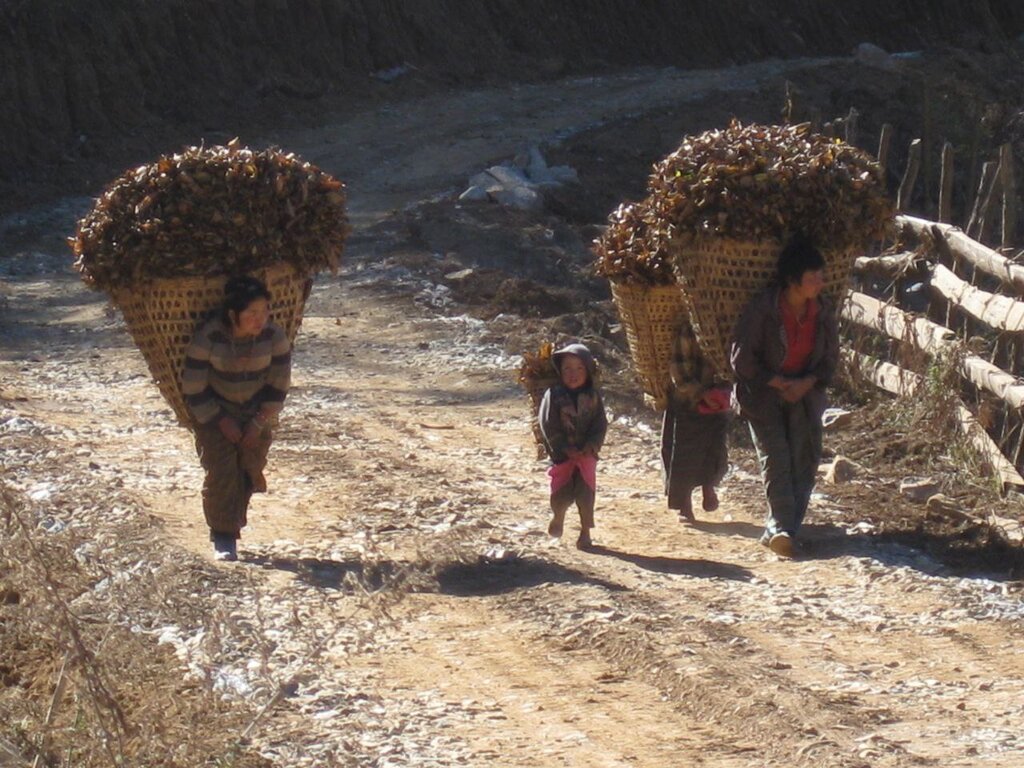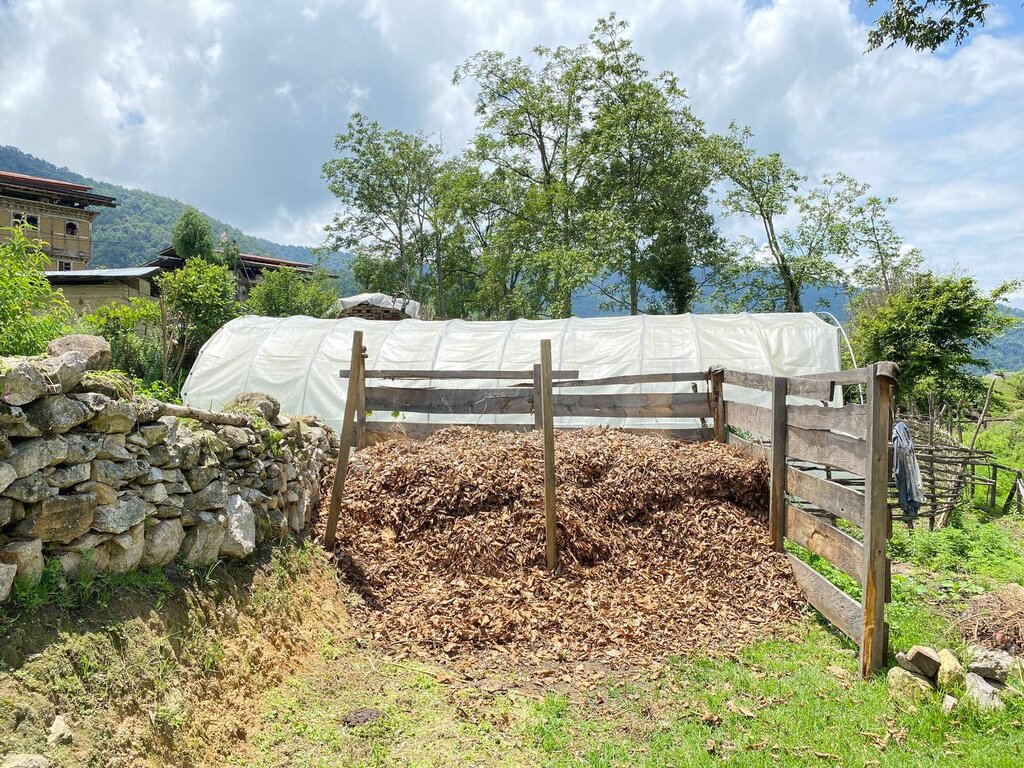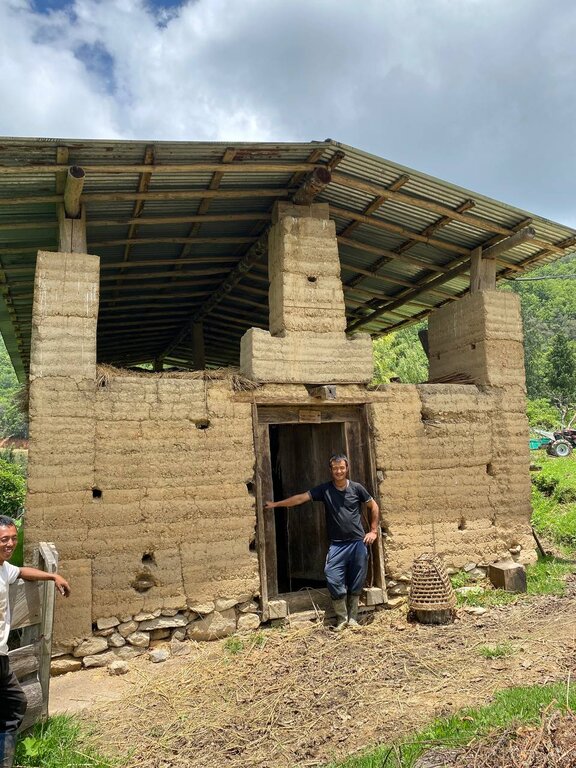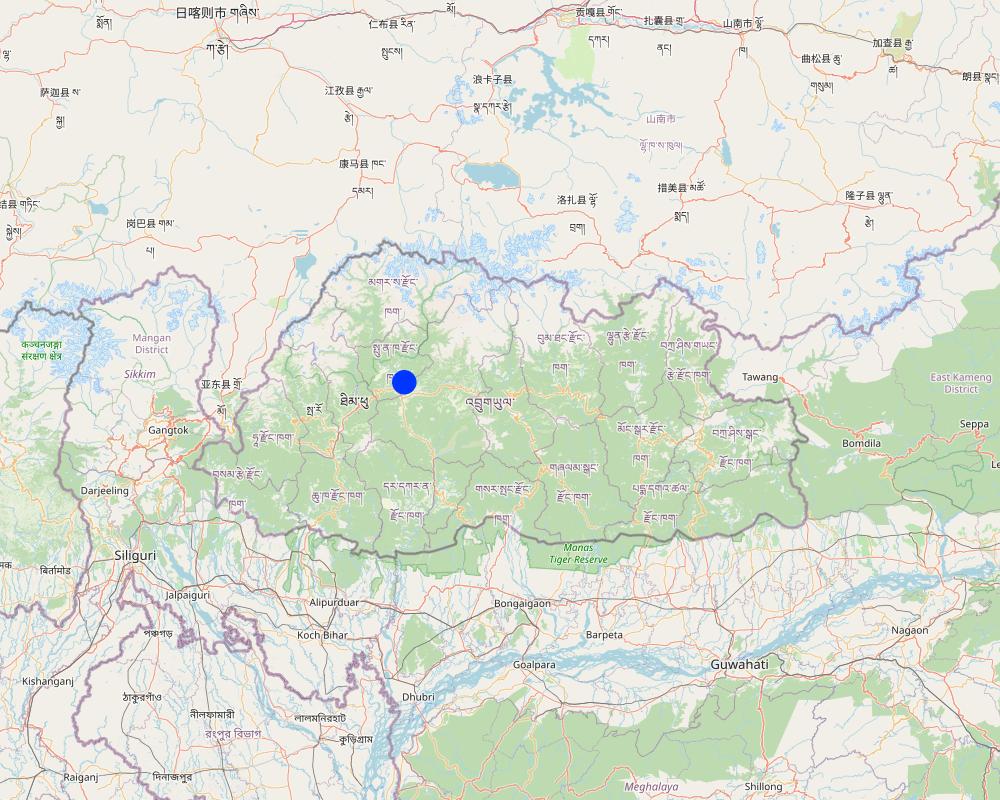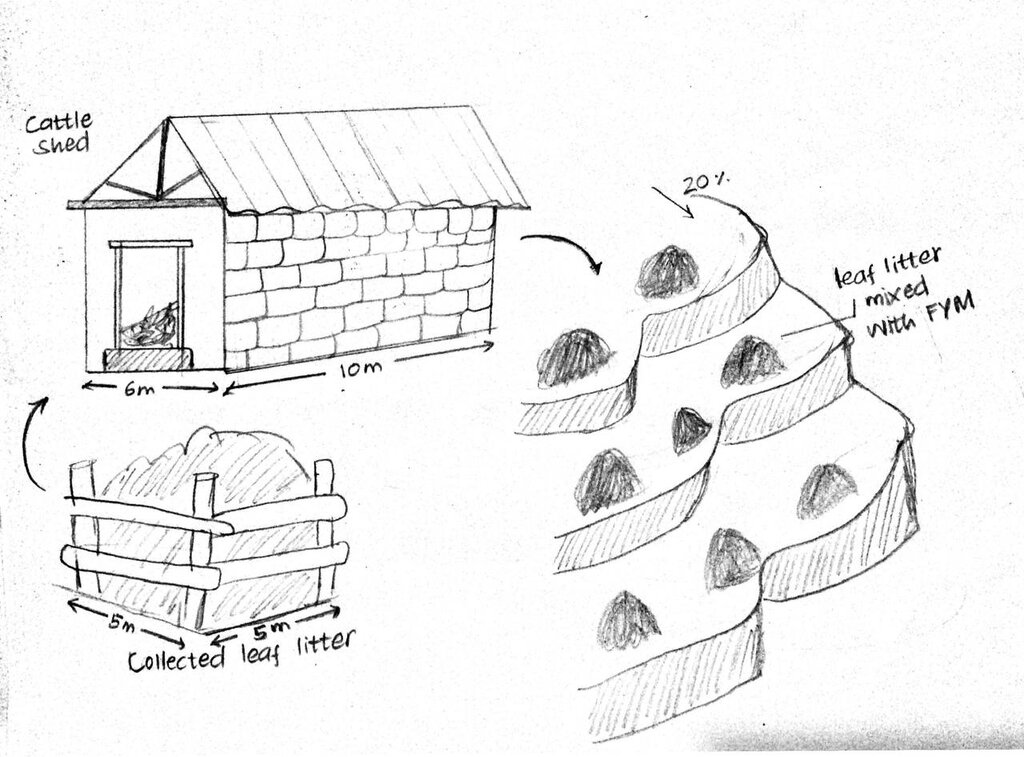Leaf Litter Collection for FYM Production [Bhutan]
- Creation:
- Update:
- Compiler: Karma Wangdi
- Editor: Tashi Wangdi
- Reviewers: William Critchley, Rima Mekdaschi Studer
Sochhag Tey Nor Lue Zhoni (གསོ་འཕྱག་སྟེ་ནོར་ལུད་བཟོ་ནི།)
technologies_6818 - Bhutan
View sections
Expand all Collapse all1. General information
1.2 Contact details of resource persons and institutions involved in the assessment and documentation of the Technology
Key resource person(s)
land user:
Norbu Dawa
Lingmukha Chiwog (Community), Lingmukha Gewog (Block), Punakha Dzongkhag (District)
Bhutan
Name of project which facilitated the documentation/ evaluation of the Technology (if relevant)
Strengthening national-level institutional and professional capacities of country Parties towards enhanced UNCCD monitoring and reporting – GEF 7 EA Umbrella II (GEF 7 UNCCD Enabling Activities_Umbrella II)Name of the institution(s) which facilitated the documentation/ evaluation of the Technology (if relevant)
National Soil Services Center, Department of Agric (National Soil Services Center, Department of Agric) - Bhutan1.3 Conditions regarding the use of data documented through WOCAT
The compiler and key resource person(s) accept the conditions regarding the use of data documented through WOCAT:
Yes
1.4 Declaration on sustainability of the described Technology
Is the Technology described here problematic with regard to land degradation, so that it cannot be declared a sustainable land management technology?
No
Comments:
This technology is practiced for decades without any problems regarding land degradation. While leaf litter collection can have positive effects when managed sustainably, there are also potential negative impacts associated with excessive or improper leaf litter collection
2. Description of the SLM Technology
2.1 Short description of the Technology
Definition of the Technology:
Leaf litter collection is the practice of collecting leaf litter from a designated forest area called sokshing and using it as bedding material for cattle. It then forms a constituent of farmyard manure which is applied to farmland.
2.2 Detailed description of the Technology
Description:
Leaf litter collection, is the practice of collecting leaf litter from a designated forest area called sokshing and using it as bedding material for cattle. It then forms a constituent of farmyard manure which is applied to farmland. The term 'sokshing' comes from 'sok' meaning leaf litter and 'shing' meaning tree. The tradition of harvesting leaf litter from a designated forest area for agricultural use has been in practice for decades in the life of Bhutanese farmer (Chettri et al., 2012). According to BHUCAT, 2012, the use of sokshing is a widely used traditional farming practice in Bhutan with dominance in temperate regions but spreading into more humid subtropical areas. Leaf litter from the forests is used for the purpose of livestock bedding and then farmyard manure (FYM) production. Leaf litter as animal bedding is kept for a few months to almost a year. In Bhutanese society leaf litter is an important component of agriculture because of its contribution to manure production with most communities having designated specific forest management units for its production and collection for individuals or for communities. Sokshing is an important and highly relevant system and it continues to be important for villagers, even in the face of changing livelihood and institutional orientations. The government recognises sokshing and its institutions as a relevant mechanism for community forest management (Dorji et al., 2003).
Leaf litter, predominantly gathered during the winter when the leaves have fallen, is collected from the forest floor by cleaning the entire understorey. It is carried to the farm and stored before being used as bedding material for cattle, providing comfort and insulation from cold. It is then mixed with cattle manure to form farmyard manure (FYM), (BHUCAT, 2012). FYM and mineral fertilizers are the two main sources of plant nutrients in Bhutan. Farmers not only depend on forests for leaf litter but also for livestock feed and construction materials (Gautam, 2009). FYM is a mixture of animal dung, crop residues, and other organic materials and plays a vital role in enhancing soil fertility and improving crop productivity. Its application to agricultural fields provides numerous benefits. Recent research by Gupta et al. (2022) demonstrated the positive impact of FYM on soil health and crop yields. The study found that FYM application significantly increased soil organic carbon content, which is essential for soil structure, water holding capacity, and nutrient retention. Furthermore, FYM enhanced the availability of essential nutrients such as nitrogen, phosphorus, and potassium, promoting optimal plant growth and development. Additionally, FYM improved soil microbial activity, leading to enhanced nutrient cycling and improved nutrient uptake by plants.
Leaf litter collection plays a role in ecosystem health and functioning. The accumulation of fallen leaves on the forest floor contributes to nutrient cycling, soil health, and moisture retention. Despite its benefits, the sokshing process exposes the forest's soil to erosion because all the leaves, debris, and undergrowth are removed. Nutrient mining occurs over time as a result of the annual removal of leaf litter, and many sokshing forests exhibit stunted growth and other signs of forest degradation. However, on balance, when used in conjunction with dairy production, sokshing offers a low-cost, readily available supply of bedding and then organic fertilizer, although it is labour-intensive.
In some situations, there may be specific benefits in removing the litter. A recent study by Jiang et al. (2021) emphasized the importance of leaf litter collection for mitigating the negative impacts of invasive species. The research found that invasive plants can alter the decomposition rates of leaf litter, disrupting nutrient cycling and leading to changes in soil properties. By collecting leaf litter, especially in areas where invasive species are prevalent, we can minimize their detrimental effects and help preserve the ecological balance.
2.3 Photos of the Technology
2.4 Videos of the Technology
Date:
06/07/2023
Location:
Proper Lingmukha
Name of videographer:
Niki Rai
2.5 Country/ region/ locations where the Technology has been applied and which are covered by this assessment
Country:
Bhutan
Region/ State/ Province:
Bhutan
Further specification of location:
Punakha, Lingmukha
Specify the spread of the Technology:
- applied at specific points/ concentrated on a small area
Is/are the technology site(s) located in a permanently protected area?
No
Comments:
The end product, FYM, is located in the farmer's own field.
Map
×2.6 Date of implementation
If precise year is not known, indicate approximate date:
- more than 50 years ago (traditional)
2.7 Introduction of the Technology
Specify how the Technology was introduced:
- as part of a traditional system (> 50 years)
Comments (type of project, etc.):
Traditional farming practices in Bhutan
3. Classification of the SLM Technology
3.1 Main purpose(s) of the Technology
- improve production
- create beneficial economic impact
- create beneficial social impact
- Bedding materials for cattle
3.2 Current land use type(s) where the Technology is applied

Cropland
- Annual cropping
Annual cropping - Specify crops:
- cereals - barley
- cereals - other
- potatoes, chili and beans
Annual cropping system:
Vegetables - wheat/barley/oat/upland rice
Number of growing seasons per year:
- 1
Specify:
once a year
Is intercropping practiced?
No
Is crop rotation practiced?
Yes
If yes, specify:
Cereals-Vegetables
Comments:
Owner grows all the cereal crops (Locally known as 'Dru na gu'). The farm is the focus for the FYM application so that is described here.
3.3 Has land use changed due to the implementation of the Technology?
Has land use changed due to the implementation of the Technology?
- No (Continue with question 3.4)
Land use mixed within the same land unit:
Yes
Specify mixed land use (crops/ grazing/ trees):
- Agroforestry

Cropland
- Annual cropping
Annual cropping - Specify crops:
- cereals - other
- vegetables - other
- Beans, Chili, potatoes
Annual cropping system:
Vegetables - wheat/barley/oat/upland rice
Is intercropping practiced?
No
Is crop rotation practiced?
Yes
If yes, specify:
cereals- Vegetables
Comments:
Owner grows all the cereal crops (Locally known as 'Dru na gu'). The farm is the focus for the FYM application so that is described here.
3.4 Water supply
Water supply for the land on which the Technology is applied:
- mixed rainfed-irrigated
Comments:
Irrigation is relied upon for crops like chili and cole crops when rainfed conditions are insufficient.
3.5 SLM group to which the Technology belongs
- natural and semi-natural forest management
- integrated crop-livestock management
- integrated soil fertility management
3.6 SLM measures comprising the Technology

agronomic measures
- A2: Organic matter/ soil fertility
- A6: Residue management
- A7: Others
A6: Specify residue management:
A 6.3: collected

management measures
- M6: Waste management (recycling, re-use or reduce)
Comments:
They are collecting leaf litter from forest
3.7 Main types of land degradation addressed by the Technology

soil erosion by water
- Wt: loss of topsoil/ surface erosion

soil erosion by wind
- Et: loss of topsoil

biological degradation
- Bc: reduction of vegetation cover
- Bq: quantity/ biomass decline
- Bl: loss of soil life
Comments:
that farmland is protected against degradation because FYM application however, Forest land are left barren after collecting the residues exposing the area to natural calamities such as erosion, destroying natural habitats of microorganisms.
3.8 Prevention, reduction, or restoration of land degradation
Specify the goal of the Technology with regard to land degradation:
- not applicable
Comments:
While this technology may not directly address land degradation, it involves utilizing forest residues to produce farmyard manure (FYM) for crop cultivation, leading to improved fertility of the cultivated land. however there are also potential negative impacts associated with excessive or improper leaf litter collection to the forest area.
4. Technical specifications, implementation activities, inputs, and costs
4.1 Technical drawing of the Technology
Technical specifications (related to technical drawing):
Technical specifications as given above
Author:
karma Wangdi
Date:
06/07/2023
4.2 General information regarding the calculation of inputs and costs
Specify how costs and inputs were calculated:
- per Technology unit
Specify unit:
Cattle shed area
Specify dimensions of unit (if relevant):
15/10
other/ national currency (specify):
Ngultrum
If relevant, indicate exchange rate from USD to local currency (e.g. 1 USD = 79.9 Brazilian Real): 1 USD =:
82.0
Indicate average wage cost of hired labour per day:
800
4.3 Establishment activities
| Activity | Timing (season) | |
|---|---|---|
| 1. | Site selection | Winter |
| 2. | Collection of cosnstruction materials | Before on set of rain |
| 3. | hiring of labors | Before the cultivation |
| 4. | Construction of the cow shed | winter |
| 5. | collection of leaf litters from the forest | winter |
| 6. | Stocking and use of leaf litter as bedding materials in the cow shed | winter |
| 7. | Let the leaf litter decompose for a month or more | anytime |
| 8. | Application of FYM during the field preparation | Before the cultivation of crops |
Comments:
Establishment is done based at his own convenience and he has to bear all the establishment cost
4.4 Costs and inputs needed for establishment
| Specify input | Unit | Quantity | Costs per Unit | Total costs per input | % of costs borne by land users | |
|---|---|---|---|---|---|---|
| Labour | person days | 15.0 | 800.0 | 12000.0 | 100.0 | |
| Equipment | Spade | no. | 6.0 | 100.0 | ||
| Equipment | crowbar | no. | 3.0 | 100.0 | ||
| Equipment | pickaxe | no. | 2.0 | 100.0 | ||
| Equipment | sickle | no. | 3.0 | 100.0 | ||
| Equipment | wire | metre | 50.0 | 100.0 | ||
| Equipment | knife | no. | 3.0 | 100.0 | ||
| Equipment | Power chain | no. | 1.0 | 98.0 | ||
| Construction material | nail | kg | 1.0 | 500.0 | 500.0 | 100.0 |
| Construction material | Timber | nos. | 150.0 | 350.0 | 52500.0 | 100.0 |
| Construction material | CGI sheet | nos. | 20.0 | 780.0 | 15600.0 | 100.0 |
| Other | Working Lunch and Refreshment | person day | 15.0 | 410.0 | 6150.0 | 100.0 |
| Total costs for establishment of the Technology | 86750.0 | |||||
| Total costs for establishment of the Technology in USD | 1057.93 | |||||
Comments:
All the cost for construction including labor charge and food are all covered by the owner
4.5 Maintenance/ recurrent activities
| Activity | Timing/ frequency | |
|---|---|---|
| 1. | Timber/wood change after damage caused by rain and heat | |
| 2. | CGI sheet replacement | |
| 3. | Leaf litter collection | |
| 4. | FYM production |
Comments:
Repairment and repayment of construction materials are done when ever there is damage caused.
4.6 Costs and inputs needed for maintenance/ recurrent activities (per year)
| Specify input | Unit | Quantity | Costs per Unit | Total costs per input | % of costs borne by land users | |
|---|---|---|---|---|---|---|
| Labour | person | 10.0 | 800.0 | 8000.0 | 100.0 | |
| Equipment | spade | nos | 5.0 | 100.0 | ||
| Equipment | crowbar | nos | 3.0 | 100.0 | ||
| Equipment | pickaxe | nos | 2.0 | 100.0 | ||
| Equipment | sickle | nos | 3.0 | 100.0 | ||
| Equipment | wire | metre | 20.0 | 100.0 | ||
| Equipment | knife | nos | 3.0 | 100.0 | ||
| Fertilizers and biocides | Urea | packets | 2.0 | 1300.0 | 2600.0 | 100.0 |
| Construction material | Nail | kg | 0.5 | 250.0 | 125.0 | 100.0 |
| Construction material | Timber change | nos. | 30.0 | 150.0 | 4500.0 | 100.0 |
| Construction material | CGI sheet change | nos. | 8.0 | 780.0 | 6240.0 | 100.0 |
| Other | Working lunch and Refreshment | Per Person | 10.0 | 410.0 | 4100.0 | 100.0 |
| Total costs for maintenance of the Technology | 25565.0 | |||||
| Total costs for maintenance of the Technology in USD | 311.77 | |||||
Comments:
Maintenance cost are all borne by the owner
4.7 Most important factors affecting the costs
Describe the most determinate factors affecting the costs:
There are no additional off-farm income-generating activities besides vegetable production, which has an impact on the overall costs.
5. Natural and human environment
5.1 Climate
Annual rainfall
- < 250 mm
- 251-500 mm
- 501-750 mm
- 751-1,000 mm
- 1,001-1,500 mm
- 1,501-2,000 mm
- 2,001-3,000 mm
- 3,001-4,000 mm
- > 4,000 mm
Specify average annual rainfall (if known), in mm:
1000.00
Specifications/ comments on rainfall:
Annual rainfall ranges from 500 mm to 1500 mm
Indicate the name of the reference meteorological station considered:
National center for hydrology and metrology
Agro-climatic zone
- semi-arid
This area probably falls under warm temperate zone which is one of the Bhutan's agro-climatic zone.
5.2 Topography
Slopes on average:
- flat (0-2%)
- gentle (3-5%)
- moderate (6-10%)
- rolling (11-15%)
- hilly (16-30%)
- steep (31-60%)
- very steep (>60%)
Landforms:
- plateau/plains
- ridges
- mountain slopes
- hill slopes
- footslopes
- valley floors
Altitudinal zone:
- 0-100 m a.s.l.
- 101-500 m a.s.l.
- 501-1,000 m a.s.l.
- 1,001-1,500 m a.s.l.
- 1,501-2,000 m a.s.l.
- 2,001-2,500 m a.s.l.
- 2,501-3,000 m a.s.l.
- 3,001-4,000 m a.s.l.
- > 4,000 m a.s.l.
Comments and further specifications on topography:
Altitude:
slope angles: 3%
5.3 Soils
Soil depth on average:
- very shallow (0-20 cm)
- shallow (21-50 cm)
- moderately deep (51-80 cm)
- deep (81-120 cm)
- very deep (> 120 cm)
If available, attach full soil description or specify the available information, e.g. soil type, soil PH/ acidity, Cation Exchange Capacity, nitrogen, salinity etc.
Soil Type: Sandy clay loam
MC (%): 6.84
OM (%): 7.98
OC (%): 4.64
pH (H20): 5.98
EC (µs/cm): 250.20
N (%):0.23
P (ppm):0.33
K (mg/100ml):140.07
5.4 Water availability and quality
Availability of surface water:
good
Water quality (untreated):
good drinking water
Water quality refers to:
surface water
Is water salinity a problem?
No
Is flooding of the area occurring?
No
5.5 Biodiversity
Species diversity:
- medium
Habitat diversity:
- medium
Comments and further specifications on biodiversity:
The region comprises a mixture of forest, shrub-land, wetlands, alpine habitats, agricultural land, and areas around human habitation
5.6 Characteristics of land users applying the Technology
Sedentary or nomadic:
- Sedentary
Market orientation of production system:
- mixed (subsistence/ commercial)
Off-farm income:
- less than 10% of all income
Relative level of wealth:
- average
Individuals or groups:
- individual/ household
Level of mechanization:
- manual work
Gender:
- women
- men
Age of land users:
- middle-aged
Indicate other relevant characteristics of the land users:
Owner is a native of Lingmukha
5.7 Average area of land used by land users applying the Technology
- < 0.5 ha
- 0.5-1 ha
- 1-2 ha
- 2-5 ha
- 5-15 ha
- 15-50 ha
- 50-100 ha
- 100-500 ha
- 500-1,000 ha
- 1,000-10,000 ha
- > 10,000 ha
Is this considered small-, medium- or large-scale (referring to local context)?
- medium-scale
Comments:
He owns 5 acres of land where by he cultivates cereals, vegetables and some fruit trees
5.8 Land ownership, land use rights, and water use rights
- Family
- Family
Water use rights:
- communal (organized)
Are land use rights based on a traditional legal system?
Yes
Specify:
Water User Group and bylaws
5.9 Access to services and infrastructure
health:
- poor
- moderate
- good
education:
- poor
- moderate
- good
technical assistance:
- poor
- moderate
- good
employment (e.g. off-farm):
- poor
- moderate
- good
markets:
- poor
- moderate
- good
energy:
- poor
- moderate
- good
roads and transport:
- poor
- moderate
- good
drinking water and sanitation:
- poor
- moderate
- good
financial services:
- poor
- moderate
- good
Comments:
Many of the household are average earned farmers so they are accessible to good infrastructure facilities.
6. Impacts and concluding statements
6.1 On-site impacts the Technology has shown
Socio-economic impacts
Production
crop production
Comments/ specify:
After the SLM technology, crop production doubled in case of chili and cole crops.
crop quality
Comments/ specify:
The introduction of hybrid crops has enhanced crop quality, but it is challenging to quantify this improvement in terms of specific quantities.
animal production
Comments/ specify:
Enhanced bedding materials and improved living conditions for livestock animals have led to increased product production.
well this is professional estimates.
Income and costs
expenses on agricultural inputs
Comments/ specify:
They are continuing the traditional farming practices
farm income
Comments/ specify:
Farm production costs are minimal as they can produce their own organic manure directly from the field
diversity of income sources
Comments/ specify:
The integration of livestock and agriculture production provides farmers with various sources of income, including earnings from animal products
Socio-cultural impacts
food security/ self-sufficiency
Comments/ specify:
The impact of technology on food security or self sufficiency cannot be quantified however in their opinion there is increase in food production after the technology. Now they can commercialized their product as well as adequate for self consumption.
Ecological impacts
Soil
soil moisture
Comments/ specify:
Soil moisture has been improved in the applied field where they are practising from olden days
soil cover
Comments/ specify:
The forest's land cover has reduced because of leaf litter collection.
Specify assessment of on-site impacts (measurements):
Soil fertility and crop production improvement after technology.
6.2 Off-site impacts the Technology has shown
downstream siltation
Specify assessment of off-site impacts (measurements):
Disturbance to microorganisms and soil vegetation of forest. There may be downstream siltation if too much forest is denuded.
6.3 Exposure and sensitivity of the Technology to gradual climate change and climate-related extremes/ disasters (as perceived by land users)
Gradual climate change
Gradual climate change
| Season | increase or decrease | How does the Technology cope with it? | |
|---|---|---|---|
| annual temperature | increase | not well | |
| annual rainfall | decrease | not known |
Climate-related extremes (disasters)
Climatological disasters
| How does the Technology cope with it? | |
|---|---|
| drought | moderately |
6.4 Cost-benefit analysis
How do the benefits compare with the maintenance/ recurrent costs (from land users' perspective)?
Short-term returns:
neutral/ balanced
Long-term returns:
neutral/ balanced
6.5 Adoption of the Technology
- > 50%
If available, quantify (no. of households and/ or area covered):
29 households
Of all those who have adopted the Technology, how many did so spontaneously, i.e. without receiving any material incentives/ payments?
- 91-100%
Comments:
They have been using this technology for more than 5 decades without receiving materials, incentives and payments
6.6 Adaptation
Has the Technology been modified recently to adapt to changing conditions?
No
6.7 Strengths/ advantages/ opportunities of the Technology
| Strengths/ advantages/ opportunities in the land user’s view |
|---|
| Soil fertility improvement |
| Improved crop production. |
| Minimise the cost for buying chemical fertilizers. |
| Strengths/ advantages/ opportunities in the compiler’s or other key resource person’s view |
|---|
| Enhance soil structure |
| Sustainable nutrient recycling |
| Cost effective option or low cost technology |
6.8 Weaknesses/ disadvantages/ risks of the Technology and ways of overcoming them
| Weaknesses/ disadvantages/ risks in the land user’s view | How can they be overcome? |
|---|---|
| Habitat alteration | Reforestation and one alternative can be use of kitchen waste |
| Labor intensive | Labor exchange and power tillers for transportation |
| Weaknesses/ disadvantages/ risks in the compiler’s or other key resource person’s view | How can they be overcome? |
|---|---|
| Depletion of forest recourses | Strong policy on leaf litter collection |
7. References and links
7.1 Methods/ sources of information
- field visits, field surveys
1
- interviews with land users
1
- compilation from reports and other existing documentation
1
When were the data compiled (in the field)?
06/07/2023
Comments:
Data were collected based on field visits and face to face interactions with the land user.
7.2 References to available publications
Title, author, year, ISBN:
NSSC Bhutan catalogue of soil and water conservation approaches and technologies, 2012
Available from where? Costs?
Website
7.3 Links to relevant online information
Title/ description:
Traditional practice of leaf litter harvesting and utilization by farmers in west-central Bhutan: Paving the way for sustainable management
URL:
https://ag2.kku.ac.th/kaj/PDF.cfm?filename=07-Rekha.pdf&id=825&keeptrack=8
7.4 General comments
This technology doesn't fit easily into the form because it has three components (litter collection/ FYM production from bedding/ application to the field
Links and modules
Expand all Collapse allLinks
No links
Modules
No modules


